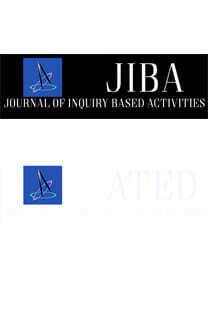ATMOSFERDEKİ SICAKLIK DEĞİŞİMİNDE ROL OYNAYAN GAZLARIN ETKİSİ: BİR STEM ETKİNLİĞİ
EFFECT OF GASES IN TEMPERATURE CHANGE IN THE ATMOSPHERE: A STEM ACTIVITY
___
- Bybee, R. W. (1997). Achieving scientific literacy: From purposes to practices. Portsmouth, UK: Heinemann.
- Bybee, R. W. (2010). Advancing STEM education: A 2020 vision. Technology and Engineering Teacher, 70(1), 30-35.
- Ceylan, S., & Özdilek, Z. (2015). Improving a sample lesson plan for secondary science course within the STEM education. Procedia-Social and Behavioral Sciences, 177, 223-228.
- Concord Consortium. (2018a). Factors that affect air quality. http://has.concord.org/air-pollution.html adresinden erişildi.
- Concord Consortium. (2018b). Exploring climate change. http://has.concord.org/global-climate.html adresinden erişildi.
- Çepni, S. (2017). Kuramdan uygulamaya STEM +A+E eğitimi. Ankara: Pegem Akademi Yayıncılık.
- Daugherty, J. (2012). Infusing engineering concepts: Teaching engineering design. National Center for Engineering and Technology Education. https://files.eric.ed.gov/fulltext/ED537384.pdf adresinden erişildi.
- Elmalı, Ş., & Balkan-Kıyıcı, F. (2017). Türkiye’de yayınlanmış FeTeMM eğitimi ile ilgili çalışmaların incelenmesi. Sakarya University Journal of Education, 7(3), 684-696.
- Gonzalez, H., & Kunezi, J. (2012). Science, technology, engineering, and mathematics (STEM) education: A primer. Washington, DC: Congressional Research Service.
- Gülhan F., & Şahin, F (2016). The effects of science-technology-engineering-math (STEM) integration on 5th grade students’ perceptions and attitudes towards these areas. Journal of Human Sciences, 13(1), 602-620.
- Hand, B., & Keys, C. (1999). Inquiry investigation: A new approach to laboratory reports. The Science Teacher, 66, 27-29.
- Kolodner, J. L. (2002). Facilitating the learning of design practices: Lessons learned from an inquiry into science education. Journal of Industrial Teacher Education, 39(3), 9-40.
- LEGO Group (2019). Mindstorms. http://www.lego.com/en-us/ Mindstorms adresinden erişildi.
- Martin, D. J. (2006). Elementary science methods: A constructivist approach. Belmont, CA: Cengage Learning.
- MEB. (2018a). Fen bilimleri dersi (3, 4, 5, 6, 7 ve 8. Sınıflar) öğretim programı. Ankara: MEB Yayınevi.
- MEB. (2018b). Bilişim teknolojileri ve yazılım dersi (5 ve 6. sınıflar) öğretim programı. Ankara: MEB Yayınevi.
- MEB. (2018c). Matematik dersi (1, 2, 3, 4, 5, 6, 7 ve 8. sınıflar) öğretim programı. Ankara: MEB Yayınevi.
- NASA Goddard (2013, January 15). NASA's analysis of 2012 global temperature [Video file]. https://www.youtube.com/watch?v=NnjTnUm9t-0 adresinden erişildi.
- National Research Council. (2012). A Framework for k-12 science education: practices, crosscutting concepts, and core ideas. Washington DC: The National Academic Press.
- Ostler, E. (2012). 21st century STEM education: A tactical model for long-range success. International Journal of Applied Science and Technology, 2(1), 28-33.
- Özmen, M. T. (2009). Sera gazı - Küresel ısınma ve Kyoto protokolü. İMO Dergisi, 43-44.
- Öztürk, N. (2008). İlköğretim yedinci sınıf öğrencilerinin fen ve teknoloji dersinde bilimsel süreç becerilerini kazanma düzeyleri (Yayımlanmamış yüksek lisans tezi). Eskişehir Osmangazi Üniversitesi Fen Bilimleri Enstitüsü, Eskişehir.
- Smith, J., & Karr-Kidwell, P. (2000). The interdisciplinary curriculum: A literary review and a manual for administrators and teachers. Retrieved from ERIC database (ED443172) at http://files.eric.ed.gov/fulltext/ED443172.pdf Stensmo, C. (1999, August). Case methodology in teacher education compared to ‘traditional’ academic teaching: A field experiment. Paper presented at the 8th European Conference for Research on learning and Instruction (EARLI). Goteborg, Sweden.
- Vanshize, (2019, February 14). Dropping a camera down a 650m-deep hole drilled in the Filchner Ice Shelf to study the Antarctic [Video file]. https://www.youtube.com/watch?v=Qtt7NbbjNg0 adresinden erişildi.
- Yıldırım, B., & Selvi, M. (2017). STEM uygulamaları ve tam öğrenmenin etkileri üzerine deneysel bir çalışma. Eğitimde Kuram ve Uygulama, 13(2), 183-210.
- Yurdakul, B. (2004). Yapılandırmacı öğrenme yaklaşımının öğrenenlerin problem çözme becerilerine, bilişötesi farkındalık ve derse yönelik tutum düzeylerine etkisi (Yayımlanmamış doktora tezi). Hacettepe Üniversitesi, Sosyal Bilimler Enstitüsü, Ankara.
- ISSN: 2146-5711
- Yayın Aralığı: Yılda 2 Sayı
- Başlangıç: 2011
- Yayıncı: Evrim Erbilgin
REFLEKS YAYI MODELİ OLUŞTURALIM: BİR STEM ETKİNLİĞİ
ELEMENTLER VE PERİYODİK SİSTEMİN ÖĞRENİLMESİNE İLİŞKİN ETKİNLİK ÖRNEĞİ
REHBERLİ ARAŞTIRMA-SORGULAMA YAKLAŞIMINA UYGUN WEB DESTEKLİ FEN MATERYALİ GELİŞTİRİLMESİ: KEMİKLER
AN ACTIVITY SHOWING HOW TO USE HISTORY OF SCIENCE IN TEACHING NATURE OF SCIENCE
ATMOSFERDEKİ SICAKLIK DEĞİŞİMİNDE ROL OYNAYAN GAZLARIN ETKİSİ: BİR STEM ETKİNLİĞİ
NAKLİYE FİRMALARI İÇİN TAŞINMA PROBLEMİ: MÜHENDİSLİK TASARIM ODAKLI ETKİNLİK ÖRNEĞİ
Esra BOZKURT ALTAN, İrem ÜÇÜNCÜOĞLU, Hüseyincan ÖZEK
LET’S FORM A REFLEX ARC MODEL: A STEM ACTIVITY
BİLİMİN DOĞASI ÖĞRETİMİNDE BİLİM TARİHİNİN NASIL KULLANILABİLECEĞİNİ GÖSTEREN BİR ETKİNLİK
DOĞADA TASARLANAN SORGULAMA TEMELLİ BİR BİLİM ETKİNLİĞİ: MİLLİ PARK’IN BİYOÇEŞİTLİLİĞİ TEHLİKEDE!
